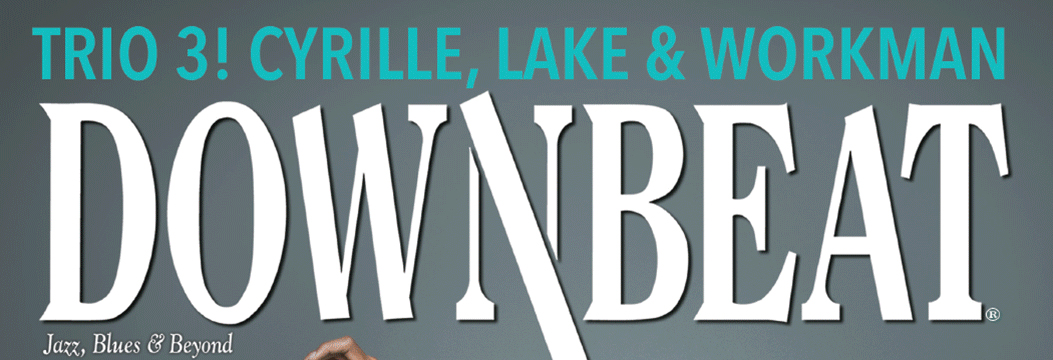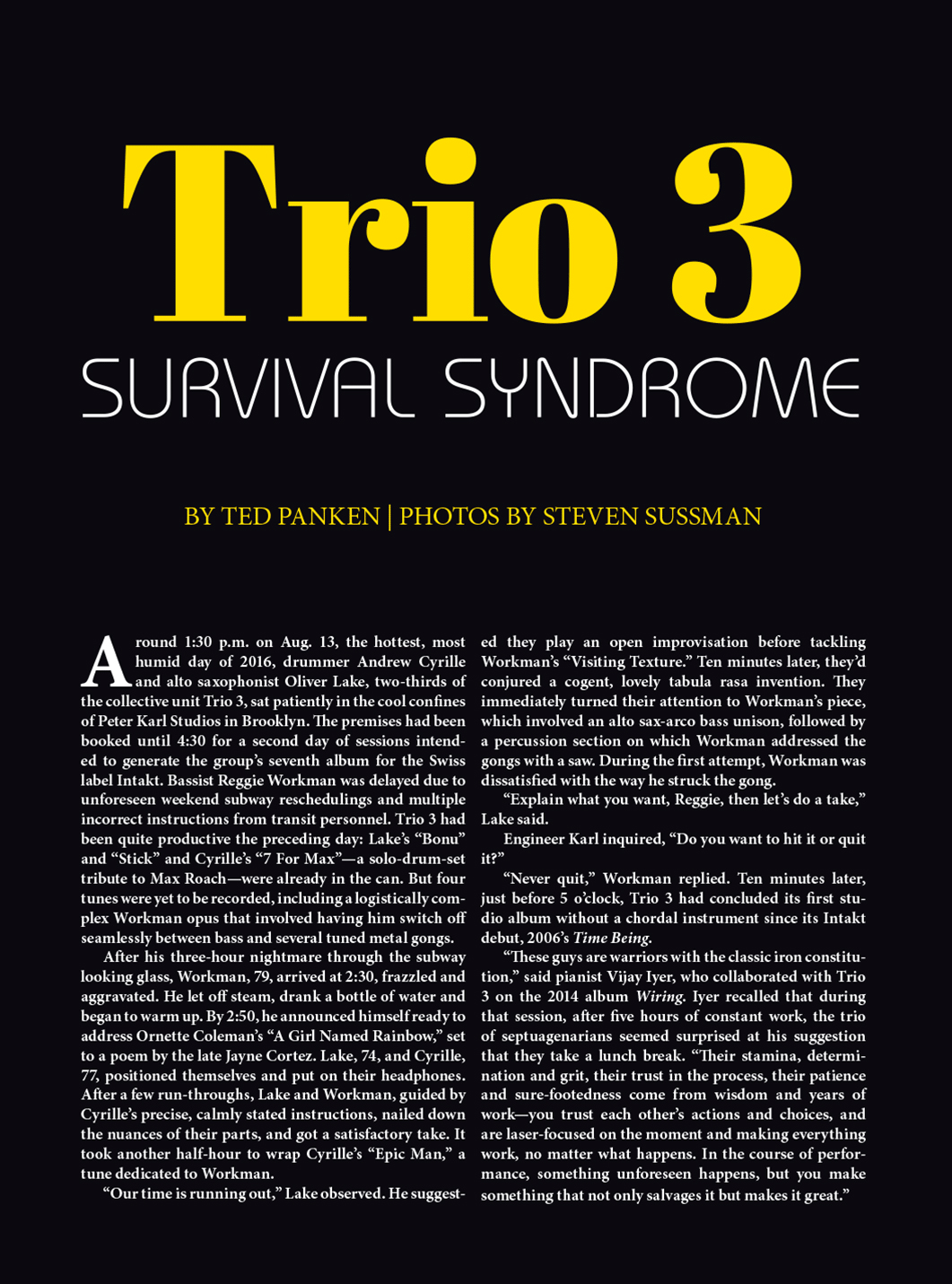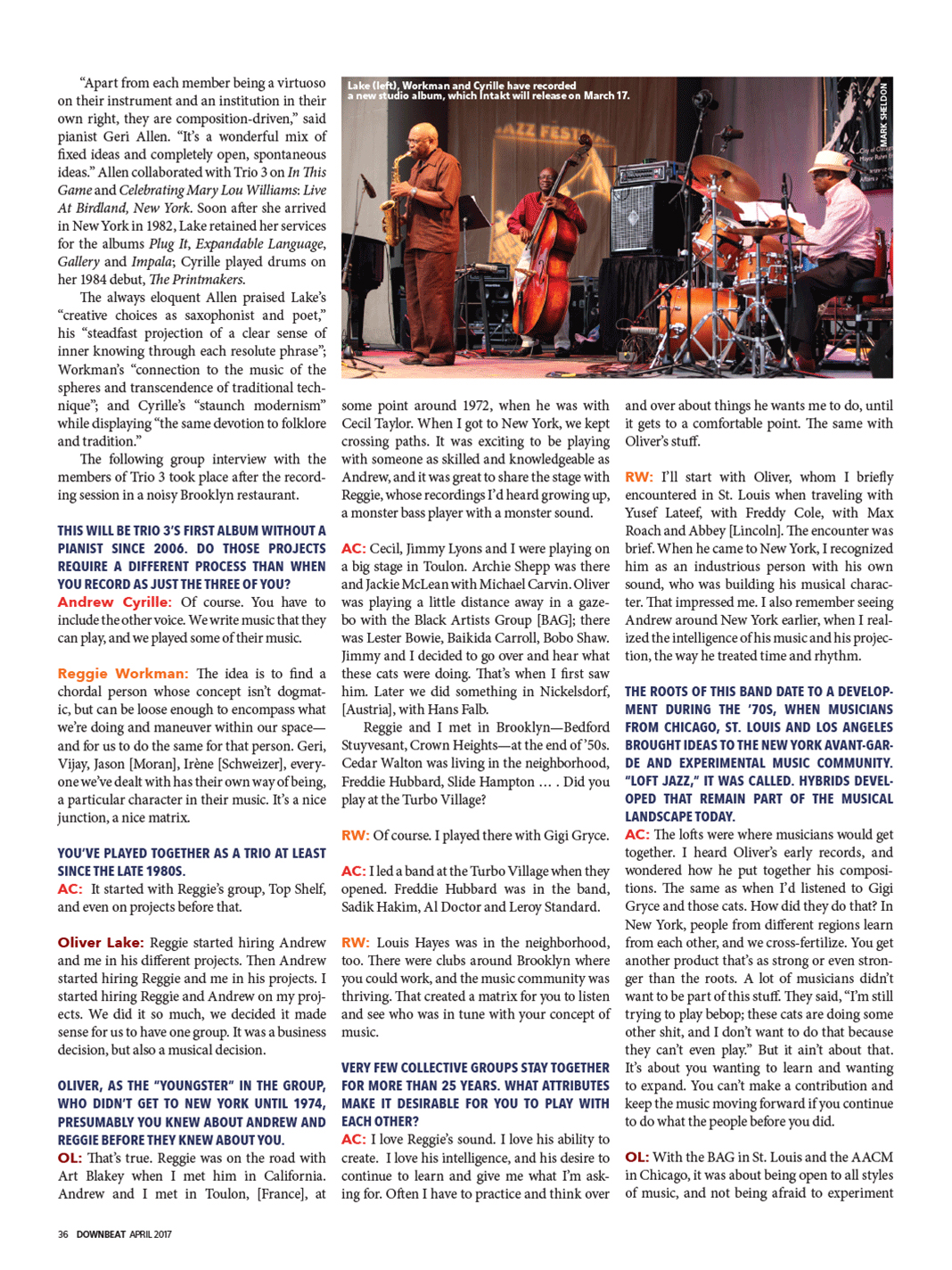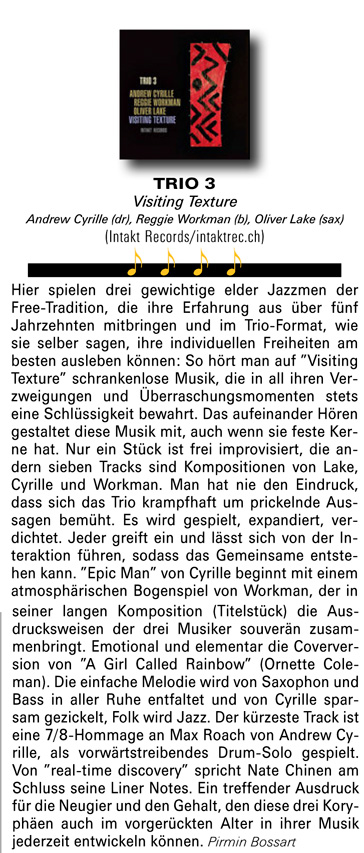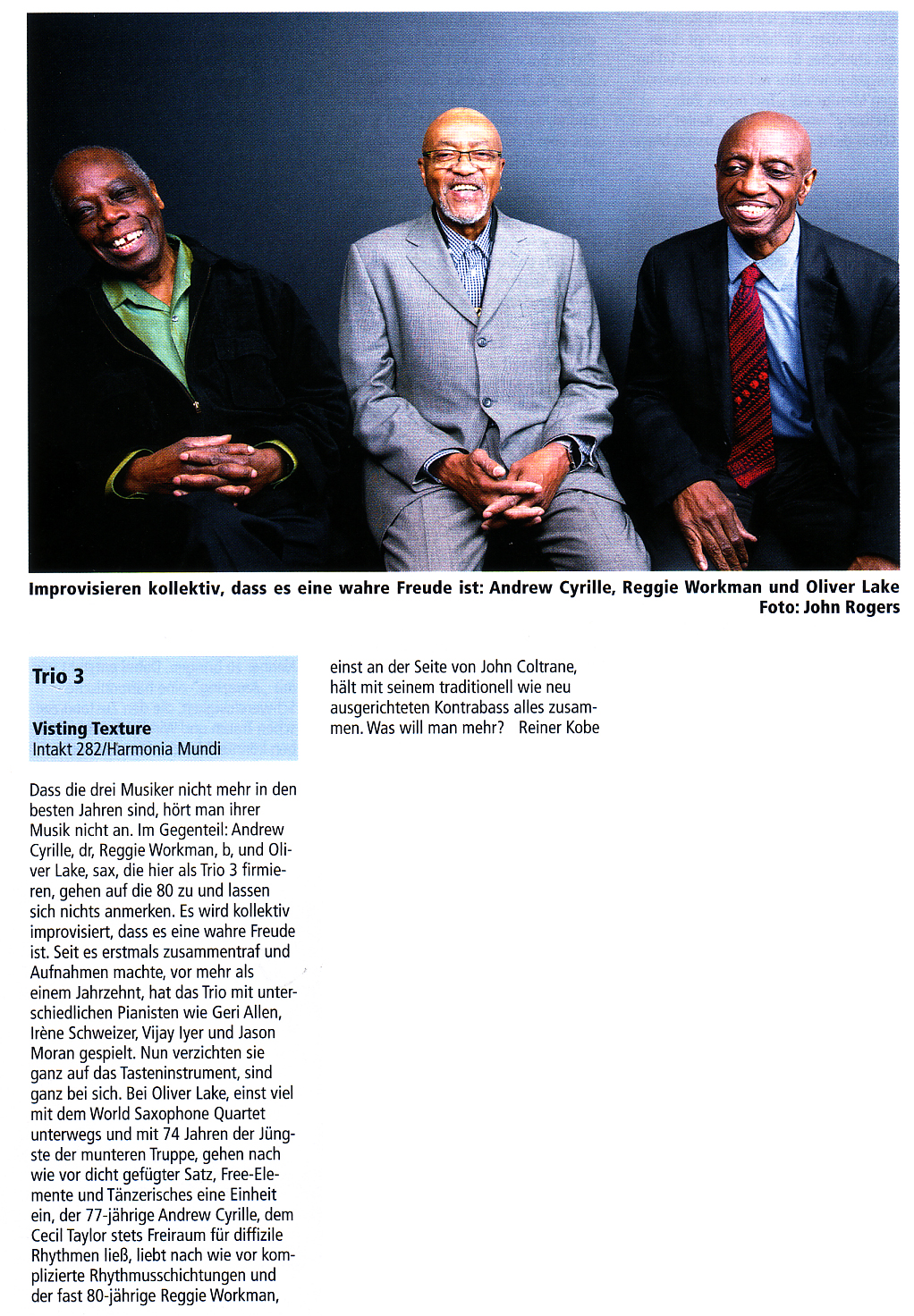INTAKT
RECORDS –
CD-REVIEWS
TRIO 3
ANDREW CYRILLE, REGGIE WORKMAN, OLIVER LAKE
Visiting Testure
Intakt CD 282 / 2017
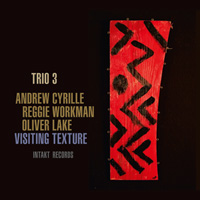
Ted Panken, Downbeat, Chicago, April 2017
Aldo del Noce, Jazz Convention, 6 Marzo 2017
Während eine Feier nach der andern sich abzeichnet, Pierre Favres 80. im Juni und vorher schon Barry Guys 70. im April (im Rahmen des Intakt-Festivals in London & Zürich vom 16. - 30.4.), offerieren drei weitere Intakt-Celebrities in der kahlen Gestalt von Andrew Cyrille, Reggie Workman & Oliver Lake, kurz TRIO 3, das, was sie besonders ausgereift zu bieten haben, in Gestalt von Visiting Texture (Intakt CD 282). Auch Workman wird im Juni 80, Lake im September 75 und Cyrille im November 78, aber gequiekt wird, was die mürben Knochen hergeben. Die drei haben gut lachen, denn das mit dem swingen geht wirklich noch wie in besten Zeiten. Ohne noch etwas beweisen zu müssen. Cyrill tickelt, flockt und tockt mit ganz leichter Hand, Workmans Finger lassen die Saiten schnurren, als würde er eine Katze kraulen, und Lake spickt seine Gesänge und Murmeleien mit Altissimospitzen, ohne alle Giftigkeit, aber mit ansteckendem Spaß an der Pikanterie solcher Zacken. Zacken, auch im Muster seiner Coverkunst, sind seine Spezialität, etwas, das herausragt aus einem zartbitteren, nämlich leicht melancholischen Grundgeschmack. Bei 'Composite', der einzigen ganz freien Improvisation, kommt eine schrille Chilinote zum Glöckchenklang und Gestöckel von Cyrille und den Bogenstrichen und dem sonoren Walking von Workman. Cyrilles 'Epic Man' gibt ihm Gelegenheit für virtuoses Arcoglissando und 'sprechendes' Pizzikato im Call & Response mit Lake. Der wiederum bestimmt 'Stick' mit großen Intervallsprüngen und sprudelndem Tempo zu Cyrilles Blechrauschen über Holzkanten. 'A Girl Named Rainbow' stimmen sie an in wehmütiger Erinnerung an den 2015 ans Ende des Regenbogens gelangten Ornette Coleman, und Cyrille erstattet mit dem 7/8-Groove von '7 for Max' seine Dankesschuld an Max Roach.
Kenny Inaoka, JazzTokyo, No 227, March 2017
Deux saxophone-trios
El Intruso, Nueva York and Buenos Aires, 3 de marzo de 2017
Intentionally generic in moniker and reliably self-effacing in comportment, Trio 3 is nevertheless celebrating its fourth decade of existence this year. Veterans even at the time, altoist Oliver Lake, bassist Reggie Workman and drummer Andrew Cyrille joined forces in the late-1980s and their association stuck. Visiting Texture marks their eleventh venture on record together and curiously the first in a decade sans a guest member. That last distinction is an important one given a dance card that's included pianists of the caliber Geri Allen (twice), Irene Schweizer and Jason Moran. The ensemble's consistently collectivist philosophy of accepting music as its leader is also precisely what lends it so well to welcoming guests. As accommodating as the three players are to collaborators, a back-to-basics approach centering on their core association serves them well here. Eight pieces, three from Lake, three from Cyrille, one collectively improvised and a cover of an Ornette Coleman tune work as fertile fodder. "Bumper", the opening cut composed by Lake, is a holdover from an earlier session receiving its belated debut. The composer rides a buoyantly ambling beat, dropping out at cued junctures to allow his colleagues some congenial rhythmic fisticuffs. "Bonu" draws from an earlier date too, one pairing Lake with bassist William Parker also on Intakt. Cyrille's cymbal and mallet effects are a winsome addition and Workman tugs a plump, sonorous sound from his strings as Lake laces his phrasing with a dry-voiced cries and honks. "Composite" draws on the trio's considerable free improvisational skills, a reservoir representing a collective 130+ years of experience between the three musicians. Lake engages in a series of extended techniques, but Workman and Cyrille play it comparatively straight in shaping active and commensurate commentary at his flanks. A lull mid-piece proves less effective, but Workman's steady pulse rights the course before the outfit takes on any figurative water. "Epic Man" and the solo "7 for Max" are both of the drummer's design and each carries a dedicatee in Workman and (Max) Roach, respectively. Workman takes the tribute given with enthusiasm, shaping a stark series of arco patterns across the former's expanse that trigger expressive retorts from his peers. The Coleman nod, a spirited rendition of "A Girl Named Rainbow", calls back to the composer's influential late-1960s trio as spiritual antecedent to the enduring Trio 3 aesthetic. Derek Taylor, Dustedmagazine, March 21, 2017
Hannes Schweiger, Concerto, Österreich, April 2017
Claudio Sessa, Corriere della Sera, Domenica 5 Marzo 2017
Russ Musto, New York City Jazz Records, May 2017, USA
Jetzt sind bei Intakt zwei CDs herausgekommen, die zum Vergleich verführen, wobei das natürlich schwierig ist, noch dazu bei zwei Platten, bei denen das Niveau, die Technik, der Einfallsreichtum etc. sowieso außer Frage stehen. Aber sie haben einiges Gemeinsames und sind doch sehr unterschiedlich. Es handelt sich bei allen Beteiligten um ein wenig in die Jahre gekommene Avantgardisten vergangener Tage. Der jüngste ist David Murray, der älteste Reggie Workman, Bassist des Trio 3. Saxofonist des Trios ist niemand Geringerer als Oliver Lake, den mit Murray eine gemeinsame Vergangenheit im World Saxophone Quartett verbindet. Auf beiden CDs werden Originale der Beteiligten dargeboten – bis auf je eine Nummer, bei Takase/Murray ist es ein Stück von Thelonious Monk, mit dem sich vor allem Takase viel beschäftigt, beim Trio eines von Ornette Coleman. Beide CDs sind makellos musiziert, Murray und Takase achten auf Abgeklärtheit und zuweilen ein wenig übertrieben auf Schönklang. Blues und Gospelartiges spielen eine Rolle. Da teilt David Murray ein wenig die musikalischen Ansichten seines Instrumentalkollegen Archie Shepp, der sich auch vom Revoluzzer zum in sich gekehrten quasi Traditionalisten gewandelt hat. Wenn er aber die Bassklarinette spielt, ist das schon hinreißend, wahrscheinlich die beste seit Eric Dolphy, und sein Einvernehmen mit Takase ist blind und souverän. Frischer klingt die Platte des Trio 3, obwohl Reggie Workman, Oliver Lake und Andrew Cyrille schon auf die 80 zugehen. Da blitzt bei aller Schönheit immer noch so etwas wie ein anarchistischer Schalk durch, der ungebrochene Wille, sich die Welt noch einmal neu zu erfinden, da sind die musikalischen Diskurse ein wenig kontroverser und deshalb auch spannender. Ganz großartiger Tonträger. haun, Freistil 72, Österreich, Mai/Juni 2017
Pirmin Bossart, Jazz'n'More, Mai/Juni 2017, Schweiz
Oliver Lake flaunts his ability to make the virtuoso bassist and John Coltrane alum, Reggie Workman and the drummer and Cecil Taylor alum Andrew Cyrille dance to his tunes in a series of death-defying high-wire escapades. In extraordinary Trinitarian adventures especially typically on “Epic Man” Lake, Workman and Cyrille play their parts with uncannily earthy force. In the midst of this high-wire performance Trio 3 perform Ornette Coleman’s “A Girl Named Rainbow, Cyrille’s “7 For Max” and Reggie Workman’s “Visiting Texture”, the ultimate show-stopper, with elegance, colour and variety. Trio 3’s version of “A Girl Named Rainbow” sits proudly alongside the legendary recording by Ornette Coleman himself. The repertoire reveals Trio 3’s broad taste from Coleman to Lake, with stops along the way for music by Cyrille and Workman as once virtuoso, lyrical and deeply profound. Raul da Gama (from "The Intakt Adventure Continues"), jazzdagama.com, May 1, 2017
Kevin LeGendre, Jazzwise, June 2017
Wolf Kampmann, Jazzthetik, Mai 2017
Hiroki Sugita, Jazz Japan, June 2017
Guido Festinese, Discoclub 65, Italia, 1. Mag, 2017
Joao Santos, Expresso, Mai 2017, Portugal
Rainer Kobe, Jazzpodium, Deutschland, Juni 2017
John Sharpe, All About Jazz, June 20, 2017
Giuseppe Segalia, All About Jazz Italia, June 26, 2017
Georges Tonla Briquet, Jazzenzo, Netherlands, 14. Juni 2017
Kay Friedrichs, Klenckes, Juli 2017
Claude Loxhay, JazzAround, Belgium, August 2017
Rui Eduardo Paes, Jazz.Pt, September 2017
Jörgen Östberg, Orkesterjournalen, Sweden, November 2017
Ben Taffijn, Jazz en meer, 22.12.17
John Pietaro, The New York City Jazz Record, April 2018
Tor Hammerø, Tor de Jazz, 3.4.2018
Jean Buzelin, CultureJazz.fr, Aug 2018
Luc Bouquet, Improjazz, Février, 2019
|
